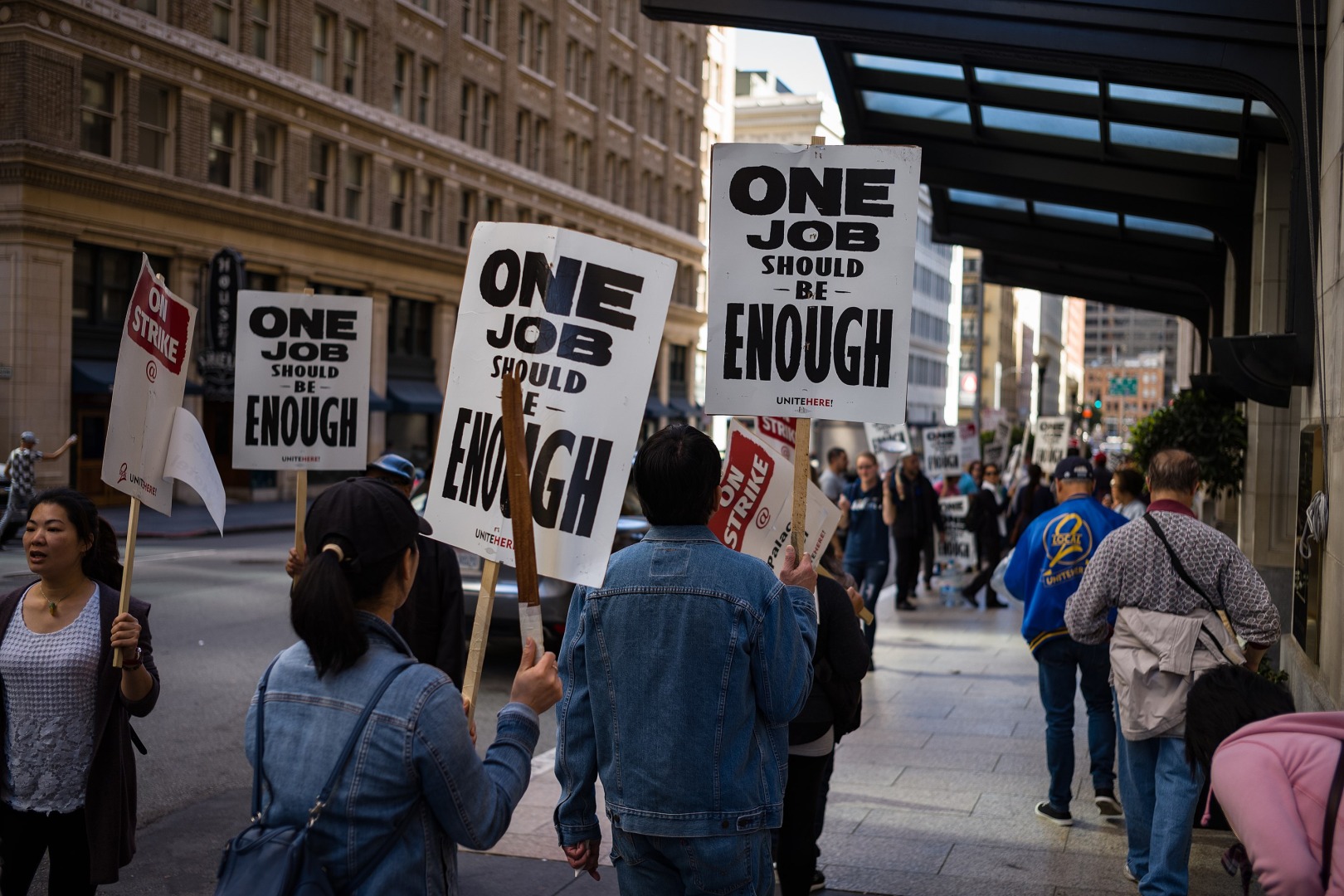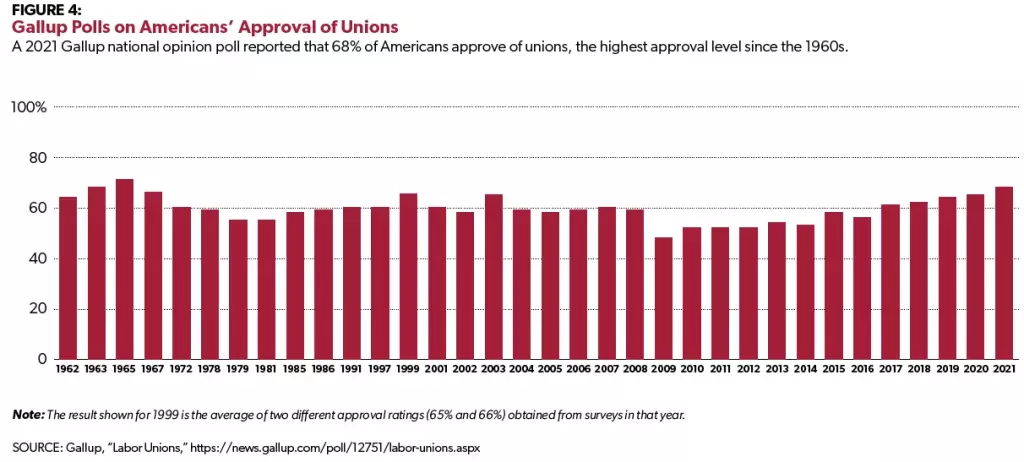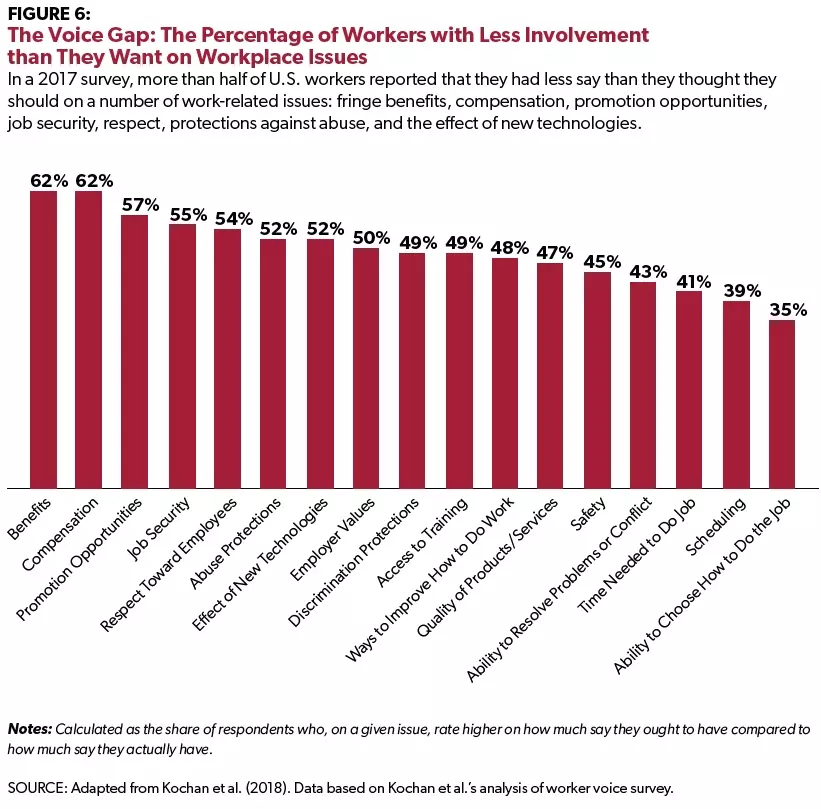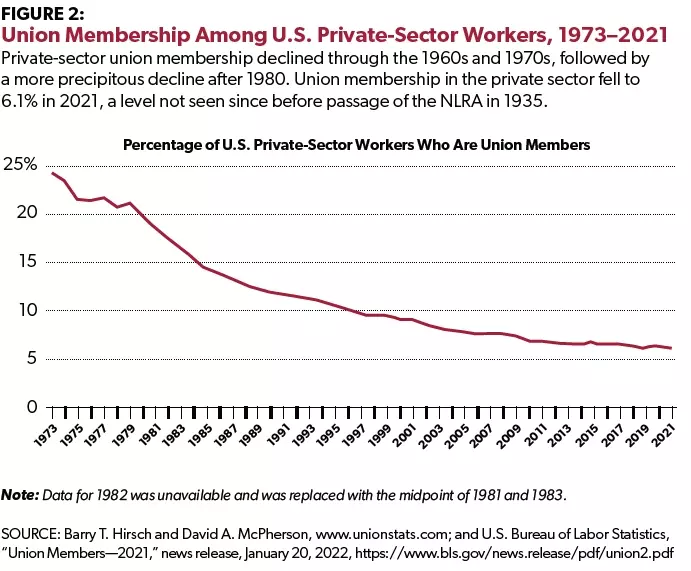Comments
- No comments found

In polling data, Americans offer strong support for labor unions.
But in practice, the share of US workers belonging to a labor union has been falling for decades. How will these competing tensions work themselves out?
A report by an interdisciplinary group of union-friendly labor market researchers under the auspices of the Worker Empowerment Research Network explores the current state of “U.S. Workers’ Organizing Efforts and Collective Actions” (June 2022). Specifically, the report is co-authored by Thomas A. Kochan, Janice R. Fine, Kate Bronfenbrenner, Suresh Naidu, Jacob Barnes, Yaminette Diaz-Linhart, Johnnie Kallas, Jeonghun Kim, Arrow Minster, Di Tong, Phela Townsend, and Danielle Twiss.
Here’s Gallup survey data on the share of Americans who say that they approve of unions. It has often hovered near 60%, the most recent survey (just available a week ago, and not shown in this graph) puts support at 71%.

In addition, a substantial share of US workers report that they would like to have more say in their workplace.

However, the share of US workers belonging to a union peaked back in the late 1940s and early 1950s at about one-third of the labor force. Here’s the share of private-sector US workers belonging to a union since the earlier 1970s.:

There are an array of possible explanations for this gap between what would seem to be support for unions and what unions can provide, and actual membership in unions. Those who support unions often emphasize that US labor law can make it hard to set up and win a union election in a given workplace. By international standards, the legal rules for setting up a union are objectively harder in the US than in most other high-income countries. However, it also seems true that many American workers who support unions in the abstract are much less supportive of unions in their own workplace, and often seem to mistrust whether an official union will focus and make progress on the day-to-day issues that matter to them as workers.
Given the steady downward trend of unionization rates over the decades, it seems unlikely that the current US legal framework for unionization is likely to lead to a renaissance of American unions any time soon. Indeed, the deeper issue here may be that the US legal framework for unionization is establishment-based–that is, it is primarily focused on workers who share a common location voting for a union. For company with many different locations–a current example is Starbucks–each location needs to vote for a union. Conversely, existing labor law about unionization is not focused on groups of workers: say, gig workers, part-time workers, workers who hold domestic jobs, adjunct professors and graduate students, farmworkers, mid-level managers, and others. The report notes:
A number of unions and other worker advocates argue that attempting to organize large, multilocation employers one location at a time is not a viable way to engage them in dialogue and/or negotiations on workers’ issues of concern. This has led to a range of different protests, mobilizing efforts, and political campaigns for new regulations aimed at gaining a voice in decision-making and governance processes at the corporate level, where key employment and labor strategies and decisions are made. To date, very few of these efforts have been successful in bringing worker and corporate management representatives to a table for dialogue. What steps, via public policy, private actions, and/or dialogue across business and worker representatives at the firm, sector, or national levels might explore ways to foster some form(s) of engagement?
When the report refers to a range of efforts, what sorts of things do they have in mind? Here are a few examples of institutions that seek to express concerns of labor, but do not involve a standard US-style dues-paying union based at a certain location:
Worker centers are “community-based mediating institutions that provide support to and organize among communities of low-wage workers. … Although worker centers were being founded throughout the 1980s and 1990s, their numbers began to increase substantially in the late 1990s. By 2005, there were at least 135 active worker centers in the U.S., up from roughly 30 in 1992. As of late 2018, there were at least 234 active worker centers in the U.S., and we have identified 12 new centers that have emerged since then.
A prominent example of a focused campaign that relies on political mobilization is Fight for $15. Started by a group of fast-food workers in New York City in 2012 with extensive financial and organizational support from SEIU and Change to Win, Fight for $15 now operates in over 300 cities and six continents. The campaign has spread beyond fast food to include other low-wage workers such as home care workers, airport workers, and adjunct professors. It relies on citywide and regional organizing committees that mobilize brief strikes in order to create political leverage and change the narrative on low-wage work.
Founded by Sara Horowitz in 1995, Freelancers Union is one of the longest-standing worker advocacy organizations that does not seek to achieve formal collective bargaining rights. A multi-occupational professional association promoting the interests of independent workers through policy advocacy, benefits provision, resources, and community building, Freelancers Union has more than 500,000 members nationwide. In recent years, Freelancers Union has pursued a variety of policy advocacy campaigns for independent contractors, including the 2017 enactment of the
Freelance Isn’t Free Act in New York City protecting independent contractors from nonpayment, and the inclusion of self-employed people in pandemic unemployment assistance benefits authorized in the CARES Act of 2020.
Coworker.org, founded in 2013, is a peer-based digital platform that provides online resources to workers engaging in workplace petition campaigns and other power-building strategies. Coworker.org’s petition site empowers workers to exercise their voice and push for better working conditions, as well as to bring greater public awareness to issues and challenges within specific worker communities. Coworker.org supports the collection of signatures among employees in organizations and also provides resources such as training, funds, and communication spaces that aim to help workers maintain large decentralized networks in workplaces. According to Coworker.org co-executive director Michelle Miller, the first two months of the pandemic saw a large increase in worker activities on the site. While dedicated to serving all types of workers, the past and current organizing activities on Coworker.org have mostly taken place in the low-wage service and retail sector and in the tech sector. Over 700 campaigns were listed on its site as this report was being prepared. Petitions target a range of issues, including wages and benefits, health and safety, the coronavirus, hiring and firing, paid sick leave, scheduling, dress code, staffing levels, discrimination and workplace harassment, training and development, and parental leave.
Accordingly, organizing among gig workers has risen, as these workers push for better working conditions. Rideshare Drivers United, Gig Workers Rising, Gig Workers Collective, New York Taxi Workers Alliance, We Drive Progress, and Mobile Workers Alliance are examples of the worker advocacy organizations that are forming among workers who provide services for app-based platforms such as food delivery and ride-hailing.
The report offers a number of other examples of these kinds of organizations, as well as examples of situations in which substantial groups of workers carried out a “sickout” or a protest to make their point, outside of the standard union framework. As mentioned already, “very few of these efforts have been successful in bringing worker and corporate management representatives to a table for dialogue,” at least so far.
Timothy Taylor is an American economist. He is managing editor of the Journal of Economic Perspectives, a quarterly academic journal produced at Macalester College and published by the American Economic Association. Taylor received his Bachelor of Arts degree from Haverford College and a master's degree in economics from Stanford University. At Stanford, he was winner of the award for excellent teaching in a large class (more than 30 students) given by the Associated Students of Stanford University. At Minnesota, he was named a Distinguished Lecturer by the Department of Economics and voted Teacher of the Year by the master's degree students at the Hubert H. Humphrey Institute of Public Affairs. Taylor has been a guest speaker for groups of teachers of high school economics, visiting diplomats from eastern Europe, talk-radio shows, and community groups. From 1989 to 1997, Professor Taylor wrote an economics opinion column for the San Jose Mercury-News. He has published multiple lectures on economics through The Teaching Company. With Rudolph Penner and Isabel Sawhill, he is co-author of Updating America's Social Contract (2000), whose first chapter provided an early radical centrist perspective, "An Agenda for the Radical Middle". Taylor is also the author of The Instant Economist: Everything You Need to Know About How the Economy Works, published by the Penguin Group in 2012. The fourth edition of Taylor's Principles of Economics textbook was published by Textbook Media in 2017.
Leave your comments
Post comment as a guest